WORLD CLASS COACHING
40 Possession Exercises
By Luca Bertolini
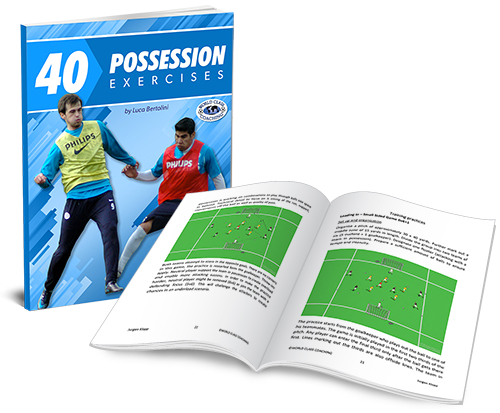
Table of Contents
PART THREE
Possession Exercises 2
Possession Exercises 2
Exercise 14 (create connections): 4 v 4 (4) - play in behind
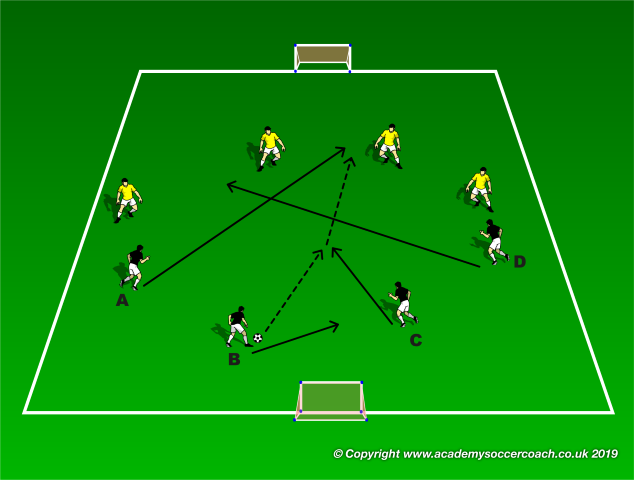
Set-up and sequence: 2 teams of 4 players each are placed in a rectangular set-up and 2 mini-goals are placed in the center of the end lines, as in the picture. The team with possession must build up and finish as follow:
• After a first forward pass (B to C), the receiver must control the ball while running forward.
• The third and fourth teammates must move, crossing the runs, to be able to receive a decisive final pass at the back of the defense line (A and D).
• C must support the attacking move behind them.
• B must provide balance at the back.
Variation: the players decide the overlapping one and the team shape positioning (but the basic shape must be respected).
Coaching points: coordinated movements of the players, speed of play to create connections, quality of passes and receptions.
Exercise 15 (create connections): 1-4-2 v 2-3-1 (3)
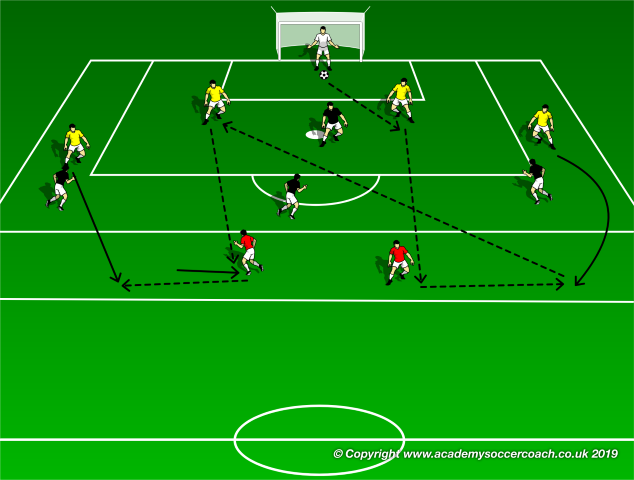
Set-up and sequence: 1 goalkeeper and 4 defenders against 4 black attackers are placed inside an area 5 yards longer than the penalty area. 2 red free players are placed inside a middle 10 yards area, acting as midfielders for both the teams. The goalkeeper passes the ball toward one of the center backs to start the sequence; the fullback must overlap to receive behind the opposition forward to keep the possession. When the second center back can receive, the fullback next to him must overlap internally to be an option for the red midfielder. The black players must put pressure against the defenders and if they win the ball, they must counter attack through crossing forward runs behind the defense line and support play sequences with the midfielders.
Coaching points: control and receive under pressure and outnumbered, create a strong area near the ball, pressure to win the ball exploiting the numerical advantage.
Exercise 16 (pass and dribble on diagonals): 3 v 2 + 2 v 2 (1)
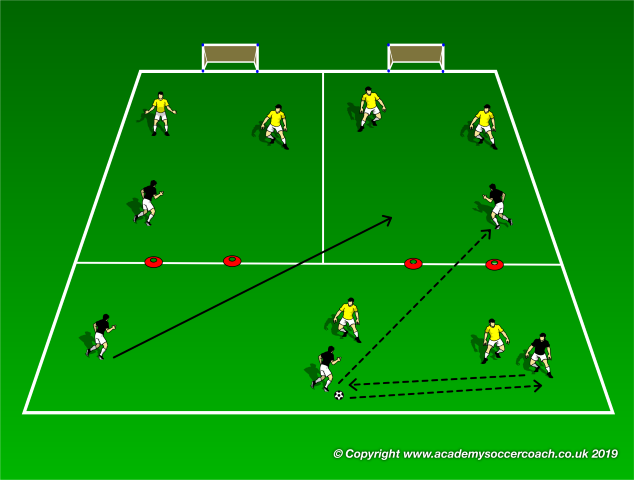
Set-up and sequence: 2 teams of 6 (yellows) and 5 (blacks) players are placed inside a 3 areas set-up. 2 cones goals are placed along the borderlines of the lower main area and of the upper finishing areas, as in the picture. A 3 v 2 duel is played inside the building up area and 2 v 1 duels are played inside the finishing areas. The team in possession must combine inside the building up area to play forward and toward one of the finishing areas, passing the ball through the cone gate. A 1 v 2 duel is played there, at the beginning; the third player must run diagonally inside to equalize the number of players, creating a 2 v 2 duel. The attacking couple must finish in the mini-goal; if the defenders win the possession, they can counter attack to score inside the cone's mini-goal. Passes and runs must always be performed on diagonals.
Coaching points: combine quickly, play on diagonals, support the attacking moves, pressure during numerical advantage situations, balance while defending with equal number of players.
Exercise 17 (pass and dribble on diagonals): 3 v 2 + 2 v 2 (2)
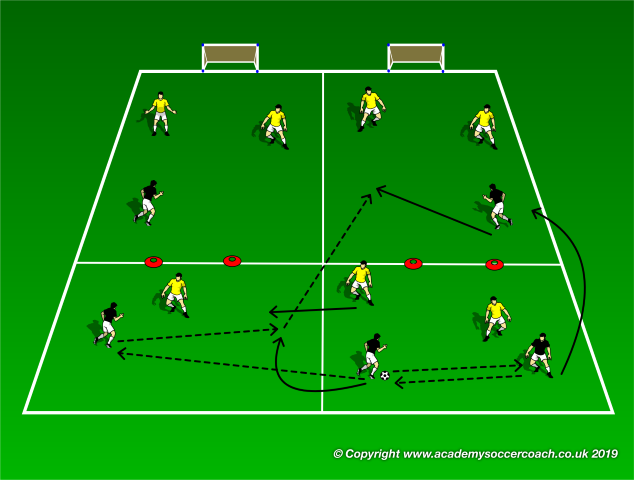
Set-up and sequence: this exercise is a variation of the previous one. 2 teams of 7 (yellows) and 5 (blacks) players are placed inside a 4 areas set-up. 2 cones goals are placed along the borderlines of the areas, as in the picture. A 3 v 2 duel is played inside the building up areas and 2 v 1 duels are played inside the finishing areas. The team in possession must combine inside the building up areas, shaping 2 v 2 momentary duels on the ball before playing forward and toward one of the finishing areas, passing the ball through the cones' gate. Both the attacking players and the defending players must shift across the lower areas to equalize the duels. A 1 v 2 duel is played inside the finishing area, at the beginning; the third player (the first in possession of the sequence) must run inside to equalize the duel, creating a 2 v 2. The attacking couple must finish in the mini-goal; if the defenders win the possession, they can counter attack to score inside the cone's mini-goal. Passes and runs must always be performed on diagonals.
Coaching points: combine quickly, shift across to support the teammate in possession, support the attacking moves, play on diagonals, pressure during numerical advantage situations, balance while defending with equal number of players.
Exercise 18 (pass and dribble on diagonals): 3 v 3 + 2
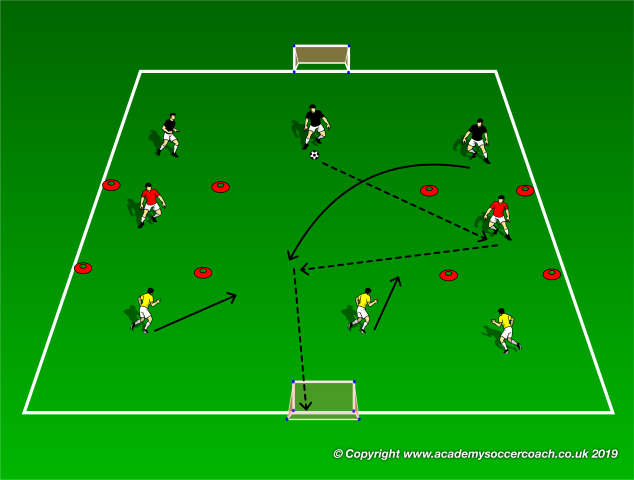
Set-up and sequence: a 3 v 3 + 2 duel is played inside a rectangular set-up. 2 goals are added in the center of the end lines and 2 small squares are placed wide in the middle of the pitch; 2 red neutral players are free to move inside. The team with possession must finish playing on diagonals toward one of the free players and after an inside run to finish, receiving the back pass from the smaller squares. The defenders must try to close the passing lanes toward the wide squares or to intercept the return passes toward the center; if they win the ball, they must counter attack in the same way toward the opposite side.
Coaching points: play on diagonals, create an attacking strong side, inside runs without the ball, closure of passing lanes.
Exercise 19 (pass and dribble on diagonals): 3 + 1 v 3 + 1
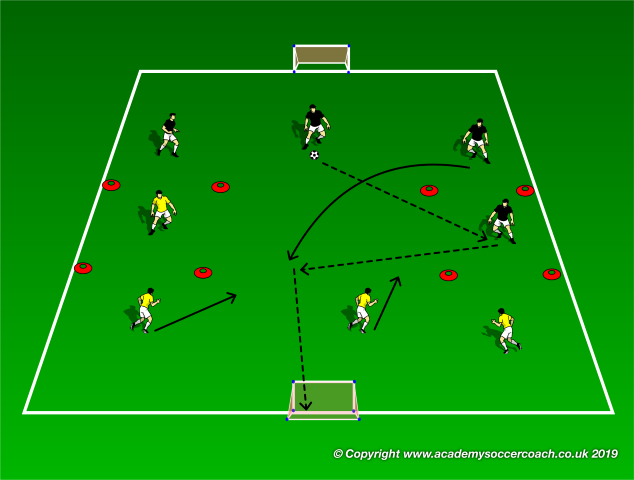
Set-up and sequence: this exercise is a variation of the previous exercise. A 3 + 1 v 3 + 1 duel is played inside a rectangular set-up. 2 goals are added in the center of the end lines and 2 small squares are placed wide in the middle of the pitch; 1 player for each team is free to move inside, as in the picture. The team with possession must finish playing on diagonals toward the teammate inside the right square and after an inside run to finish, receiving the back pass. The defenders must try to close the passing lanes toward the wide squares or to intercept the return passes toward the center; if they win the ball, they must counter attack in the same way toward the opposite side.
Coaching points: play on diagonals, create an attacking strong side, inside runs without the ball, closure of passing lanes.
Exercise 20 (pass and dribble on diagonals): 3 v 3 + 2
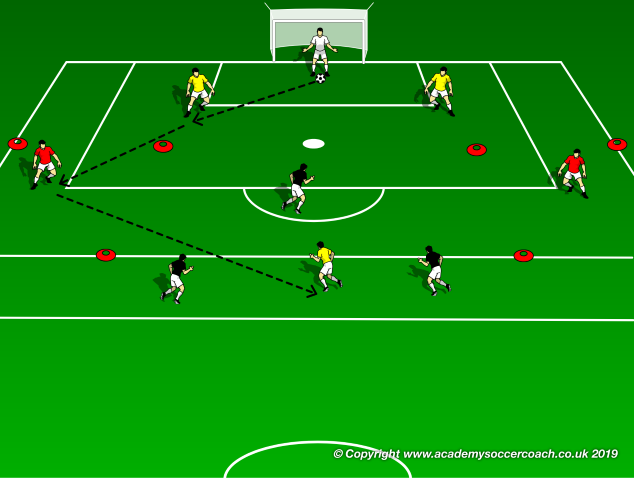
Set-up and sequence: 1 goalkeeper, 2 center backs and 1 midfielder of the building up team, 2 midfielders and 1 forward of the black team and 2 fullbacks (red free players) are placed inside a third of a regular field. The midfielders are placed inside a 10 yards area, just out of the penalty area. The goal for the yellow team is to build up, playing on diagonals toward the wide red fullbacks and from them toward the center midfielders. The forward of the black team must try to force the direction of the building up phase and the midfielders must recover the possession exploiting the numerical advantage. If they win the ball, they must counter attack, playing on diagonals with the opposite fullback, who becomes a winger in this situation.
Coaching points: build up through diagonal combinations, pressure to win the ball exploiting the numerical advantage, counter attack through the opposite side.
Exercise 21 (support play on good angles): 4 v 4 + 2
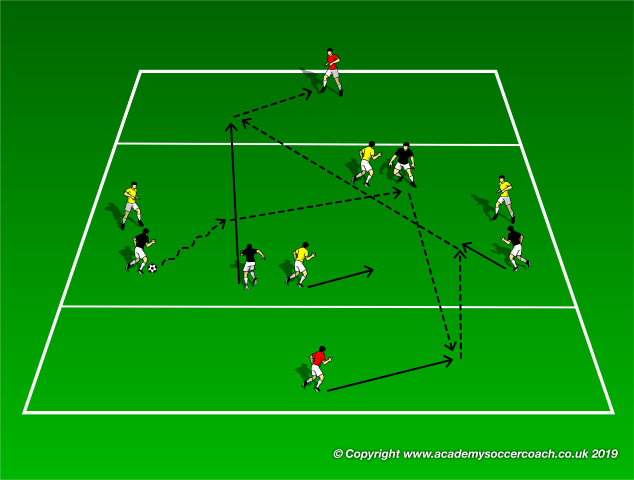
Set-up and sequence: a rectangular set-up is divided into 3 areas. A 4 v 4 duel is played in the middle and 2 red neutral players are free to move inside the outer zones. The possession team gains 1 point when the players are able to keep the possession, passing back toward the first free player and then playing toward the opposite one, who must receive a pass from an attacking player inside the outer area, as in the picture. All the players of the attacking team must be involved in the possession phase. The defenders can choose to press the possession team in the middle or to try to close the passing lanes between the outer neutral players and the attacking opponents. If they win the possession, they must play the same way.
Coaching points: build up through diagonal combinations, pressure to win the ball exploiting the numerical advantage, counter attack through the opposite side.
Exercise 22 (support play on good angles): 4 v 4 - support play
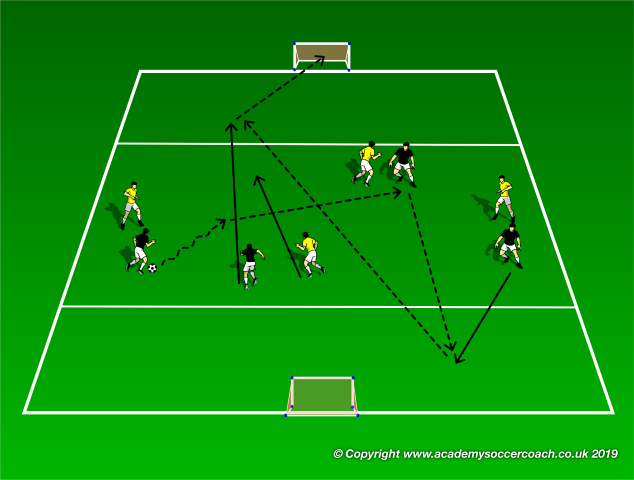
Set-up and sequence: this exercise is a variation of the previous one. A rectangular set-up is divided into 3 areas. A 4 v 4 duel is played in the middle. The possession team gains 1 point when the players are able to keep the possession, passing back toward a supporting teammate who runs back inside the first third and then playing toward the opposite one, where another teammate must receive a pass to score in the mini-goal. All the players of the attacking team must be involved in the possession phase. The defenders can choose to press the possession team in the middle or to try to close the passing lanes toward the outer areas. If they win the possession, they must play the same way.
Coaching points: build up through diagonal combinations, support the move at the back and over the last defense line, pressure to win the ball exploiting the numerical advantage, counter attack through the opposite side.
Exercise 23 (support play on good angles): 6 v 6 - back support and wide support
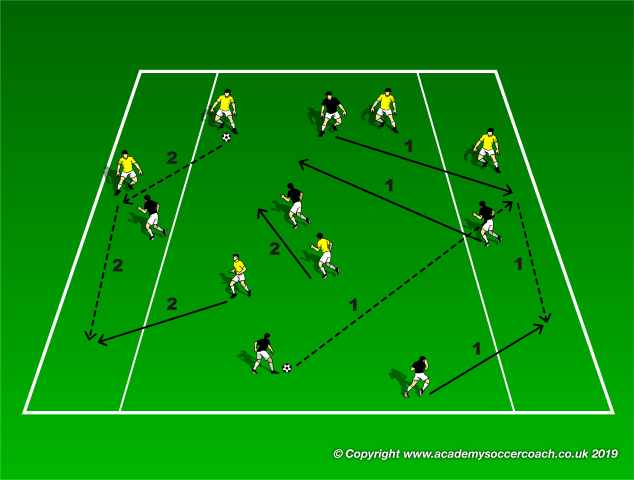
Set-up and sequence: a rectangular set-up is divided into 3 areas (a center one and 2 flanks). A 6 v 6 duel is played between 2 teams with different formations: the black team is shaped in a 2-3-1 (the advanced wingers are placed inside the flanks) and the yellow team is shaped with a 4-2 formation (the fullbacks are placed inside the flanks). The black team must attack through a wide dropping back run and back support pass (1) and the yellow team must attack through a wide forward support run, when a fullback is in possession (2).
Coaching points: back and wide support runs, combinations to free the center forward and the fullbacks and wingers.
Exercise 24 (support play on good angles): 4 + 2 v 4 + 2
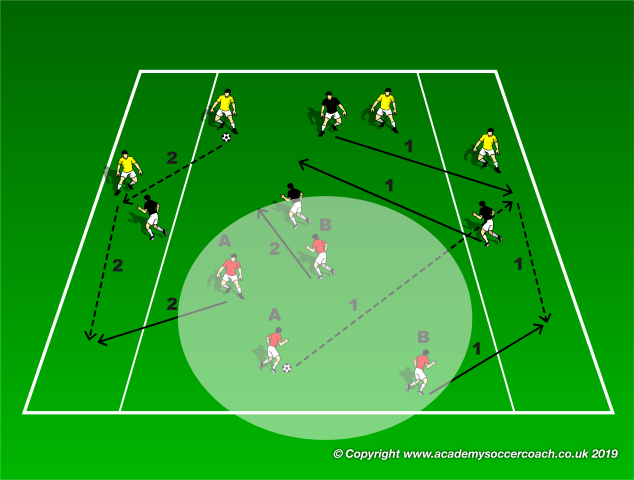
Set-up and sequence: this exercise is a variation of the previous one. A rectangular set-up is divided into 3 areas (a center one and 2 flanks). A 6 v 6 (4 + 2 v 4 + 2) duel is played between 2 teams with different formations: the black team is shaped in a 2-3-1 (the advanced wingers are placed inside the flanks) and the yellow team is shaped with a 4-2 formation (the fullbacks are placed inside the flanks).
The red free players (A and B) are the midfielders of both teams. The sequences are now alternated; if the yellow team starts the move, the midfielders must be wide support (2) and if the red players start the move, the black team must finish after a dropping back run of the center forward and wide back run of a midfielder (1). The defending team must press the opponents, even if outnumbered, to prevent them from finishing the sequence. Every complete sequence is a gained point for the team in possession.
Coaching points: back and wide support runs, combinations to free the center forward and the fullbacks and wingers.
Exercise 25 (support play on good angles):
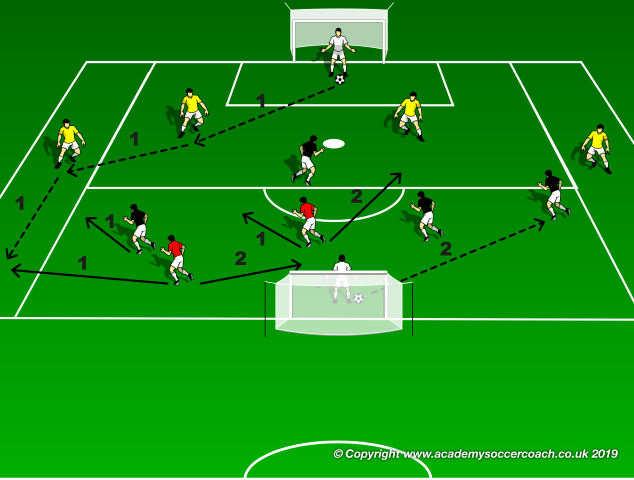
Set-up and sequence: 1 goalkeeper and 4 defenders against 4 black attackers are placed inside a third of a regular field. The field third is divided into 2 center areas and 2 flanks. 2 red free players are placed inside the lower middle, acting as midfielders for both the teams. 2 goals and goalkeepers are placed in the center of the end lines. The coach decides the goalkeeper who must start the sequence. If the goalkeeper of the yellow team starts (1), he passes the ball to a center back and then wide toward the fullback, then one red player supports the move, running wide and the second midfielder must shift across near the ball area. If the goalkeeper of the black team starts the move, the first midfielder must be a support, running forward to play as second attacker and the second midfielder must provide balance at the back. Only after these kinds of combinations, the attacks can be finished.
Coaching points: support the move running wide, shifting across, moving forward or providing balance, quick reactions to understand the roles inside the sequences.
Exercise 26 (make a pass and move): run forward the receiver
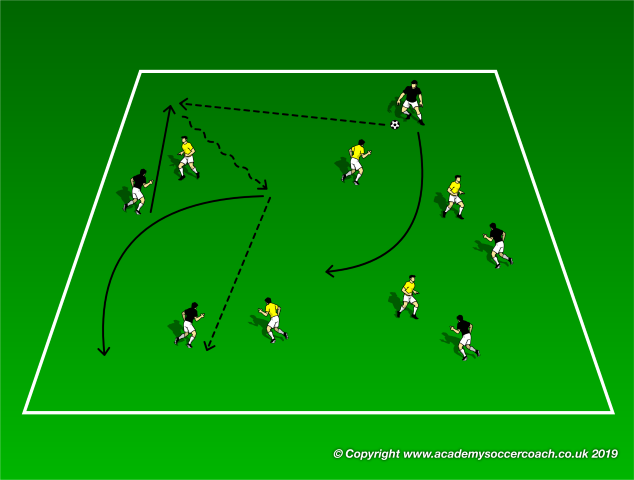
Set-up and sequence: a 5 v 5 duel is played inside a rectangular space. The possession team must keep the ball, playing in all directions with a main goal: a forward run over the receiver, but not on the same line, must follow every pass. Every 2 complete passes and movements, 1 point is gained. The defenders can choose to play 1 v 1 or to stand on potential spaces to cover them.
Coaching points: support the move running forward, be placed on different lines, space coverage.
Exercise 27 (make a pass and move): run forward the receiver and finish
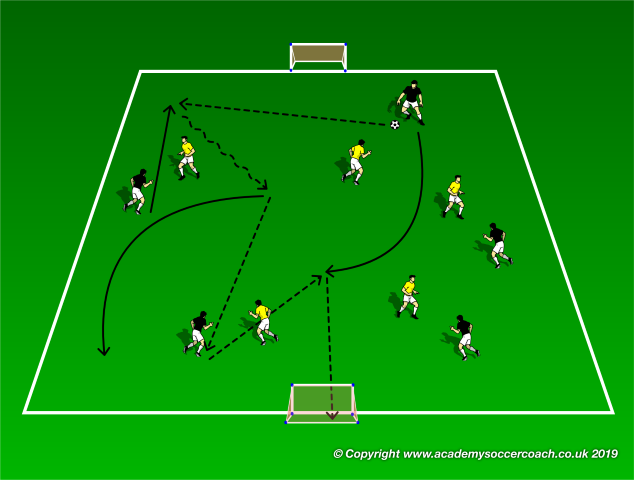
Set-up and sequence: this exercise is a variation of the previous one. A 5 v 5 duel is played inside a rectangular space. The possession team must keep the ball, playing to attack and to defend a mini-goal: a forward run over the receiver, but not on the same line, must follow every pass. Every 2 complete passes and movements, a finish attempt is possible. Scoring worth double is the player who started the move can shot. The defenders can choose to play 1 v 1 or to stand on potential spaces to cover them.
Coaching points: support the move running forward, be placed on different lines, run without the ball to finish, space coverage.


